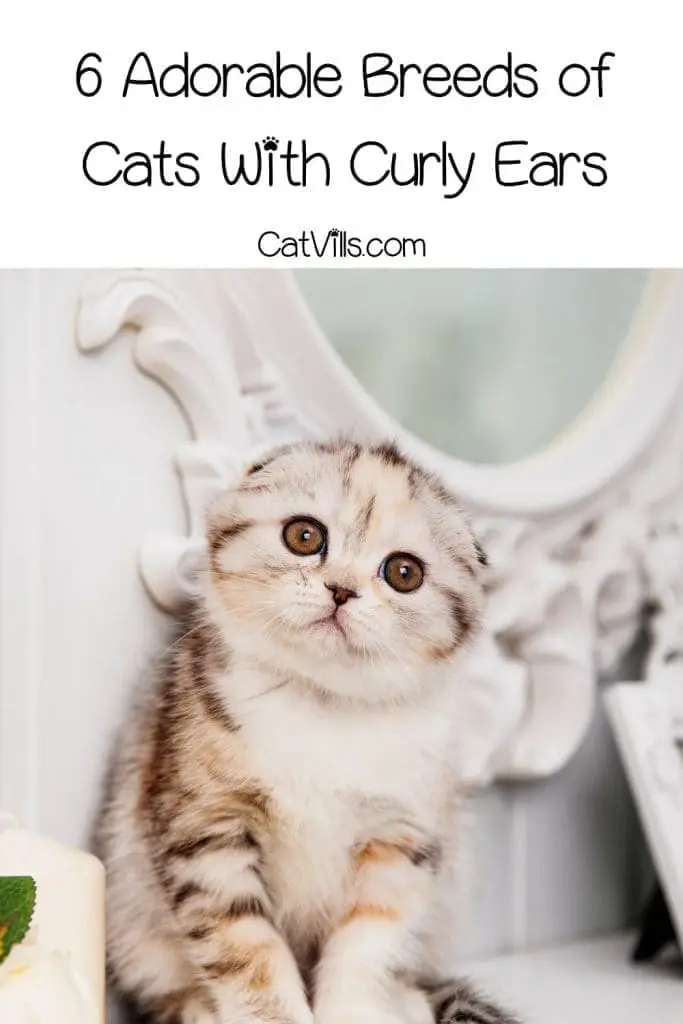Last Updated: 2 years ago
Cats breed with curled ears! That’s right. Mother Nature never ceases to amaze us.
We thought all cats had straight ears until recently, when we came across bent-ear cats, and they’re not just rare occurrences.
There are actually cats with curly ears. Please keep reading to learn more about these breeds and why their ears are different from the rest.
Cat Breeds With Curled Ears
Now let’s look at the breeds with these distinctive characteristics.
#1 American Curl
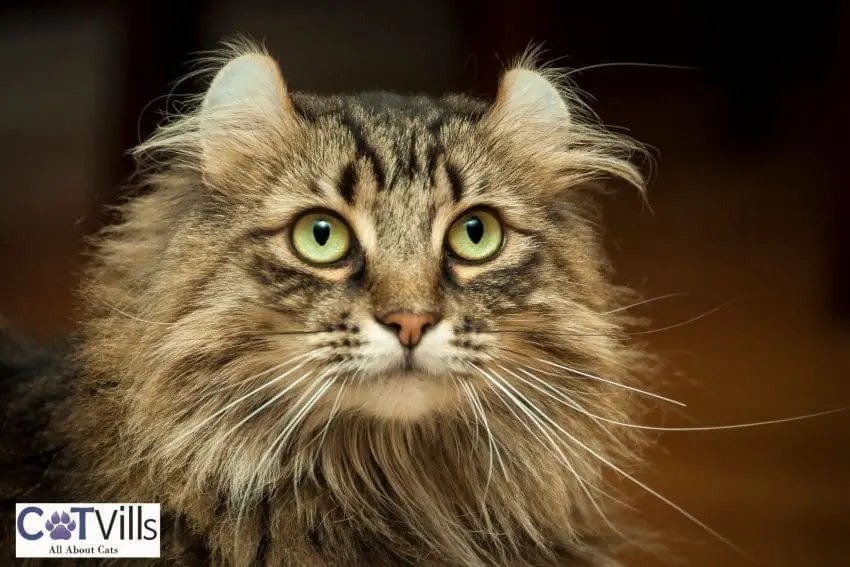
The American Curl cat breed is one of the most popular cat breeds, thanks to their distinctive curly ears.
This breed originated in California when a stray cat with unique ears named Shulamith appeared on a suburban family’s doorstep, the Rugas, in Lakewood, California, in 1981.
Later, the stray cat gave birth to four kittens, and the family realized two of the kittens had the same curly ears as their mother.
Further studies showed that the gene was dominant, and only one cat parent needed to have the gene to transfer it to the kittens.
Selective breeding with these cats started in 1983, and she was being presented in the Cat Fancier’s Association (CFA) shows by 1993, where this breed also received championship status.
Characteristics
Besides the curly ears, American Curls are known for their well-built, balanced bodies.
They can fall into the long-haired or short-haired categories since their hair length varies. And the coats also come in a variety of colors.
American Curls are not born with curled ears, though. They are born with straight ears, which then start taking shape after a few days. And the curling ceases when they are about 4 months old.
The curvature ranges from 90 degrees to 180 degrees and is a crucial determining factor for whether the cat is suitable as a pet or a show cat.
Their ears aren’t their only unique and attractive feature. They also have wedge-shaped heads and plumed tails that complement their overall build and make them even more appealing to cat fanciers.
Personality
American Curls are relatively active and energetic. That’s why they always appreciate physically stimulating games such as playing fetch.
They are also quite friendly to their owners, to strangers, and even to kids.
While they are not the most talkative cat breeds, sometimes they may vocalize in a pleasant and satisfying manner. They also love expressing their affection through headbutts, also known as bunting.
So, don’t be surprised when your kitty walks up to your bed and rubs her forehead against your chin every morning.
Health And Grooming
Some cat owners assume that, since both the Scottish Fold and American Curl share a similar genetic mutation, they also share the same genetic predisposition that affects their health.
Well, that’s not true. American Curls are pretty healthy, and they’re not susceptible to any defects. As mentioned earlier, their mutation is only responsible for curly ears.
The curled ears get pretty sensitive and accumulate dirt first. So, you should clean them regularly and check for infections.
How often you should brush their coats depends on the length of the hair. Longer hair requires regular brushing.
#2 Scottish Fold
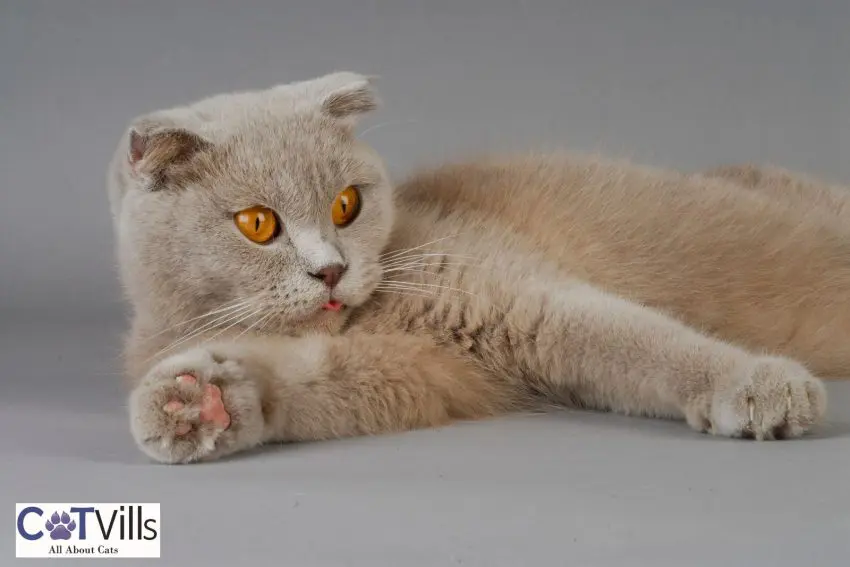
While the American Curl originated in the United States, the Scottish Fold has its roots in Scotland.
It is funny how they are from different parts of the world but still have some similarities. The mother of all Scottish Folds was a barn by the name of Susie, and she was found on a farm in Perthshire, Scotland.
Susie had a unique folding in her ears, and when she gave birth to a litter of kittens, 2 of them had acquired the folding characteristic.
The Scottish Fold was recognized by the UK’s Governing Council of the Cat Fancy (GCCF) in 1966, and breeding this cat with other breeds started the same year.
The breeders later found out that the mutation causing the folding years results from a dominant gene. This breed is also famous since Taylor Swift also owns three of them.
Characteristics
Just like American Curls, Scottish Folds aren’t born with folded ears. Their ears start folding when they’re at least 20 days old.
But instead of folding backward, they fold forward until they’re flat on the cat’s head.
Scottish Fold cats also have an overall round body, a short nose, medium-sized legs, and a medium-sized body.
They also have a thick coat, so they can either be short haired gray cats or long-haired cats.
Personality
Folds are relatively tranquil when compared to American Curls.
They may sometimes enjoy physical and mental stimulation games, but they’re not that active. Sometimes they vocalize in soft, unique voices.
They are quite affectionate, and they tend to get attached to their owners.
Folds are known for sitting in weird positions, such as the “Buddha Position,” where they lie on their backs with their paws up.
Health And Grooming
Folds can live for up to 15 years. However, they are prone to a wide range of diseases, including;
- Cardiomyopathy
- Polycystic Kidney Disease
- Degenerative joint disease: This disease affects the overall mobility of the Scottish Folds.
Osteochndrodysplasia (OCD): this abnormality causes the Folds’ ears to fold and affects bone and cartilage development.
It eventually leads to deformities and other mobility issues. This condition is known to affect all Scottish Folds.
However, Homozygous Folds (those resulting from the inbreeding of two Scottish Folds) are more susceptible. They develop the degenerative joint disease early in their lives.
Heterozygous Folds (those resulting from interbreeding Folds with other breeds) aren’t as susceptible. Some may develop deformities later in their lives, while others are just carriers.
Due to these potential health issues, the Scottish Folds are banned in the UK and countries under the Fédération Internationale Féline. Cat owners worldwide are advised to avoid cats that may develop deformities.
In Support of the ban, Vet Louise Mollaert stated that the issue is in the cartilage and will always be there. And breeding them when you’re aware of their health issues may be considered unethical.
Scottish Folds require regular coat brushing for both the long-haired and short-haired variations. The ears also need cleaning. Unfold them and clean them with a damp cloth to avoid the accumulation of dirt.
Other Cat Breeds With Curled Ears
While the curling and folding in the Scottish Fold and American Curl cats occurred naturally, breeders have tried to replicate this trait in other breeds.
This has led to the rise of new cat breeds with distinctive curly ears, among other fascinating features. Below are some of them.
#3 Highlander
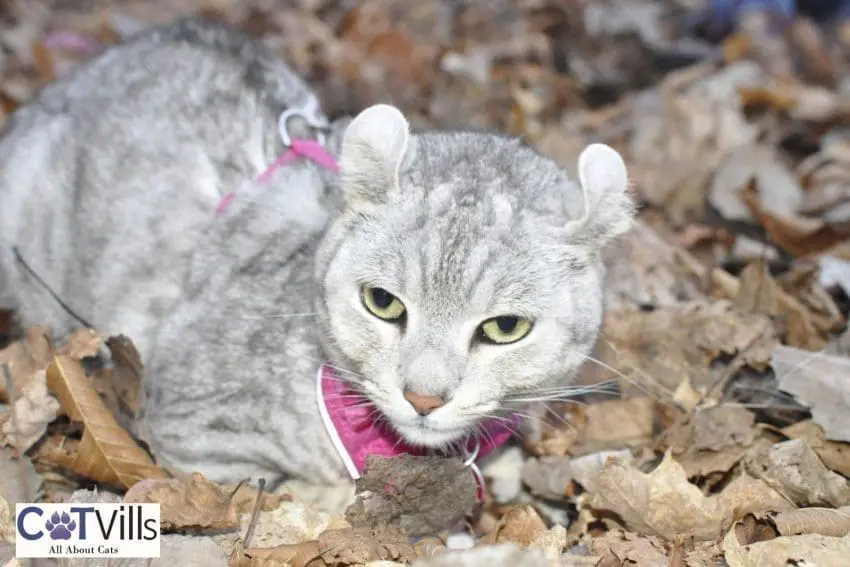
In 1993, breeders attempted to replicate the curly ears of the Jungle Curl cat in the Desert Lynx (both experimental breeds), and the results were the Highlander Cat.
This breed is also referred to as the Highlander Lynxes by the Rare and Exotic Feline Registry or the Highlander Shorthair for those with short hair.
The name “Highlander (HG)” often refers to those with longer hair.
This breed has been refined over the years, and it’s also recognized for competition by TICA (The International Cat Association).
Overall, this cat resembles a bobcat. This includes a medium-sized body, spotted markings, and a bobbed tail.
They’re also born with straight ears, which then curl backward when they’re at least two weeks old. They are also quite active, affectionate, and intelligent.
#4 Ukrainian Levkoy
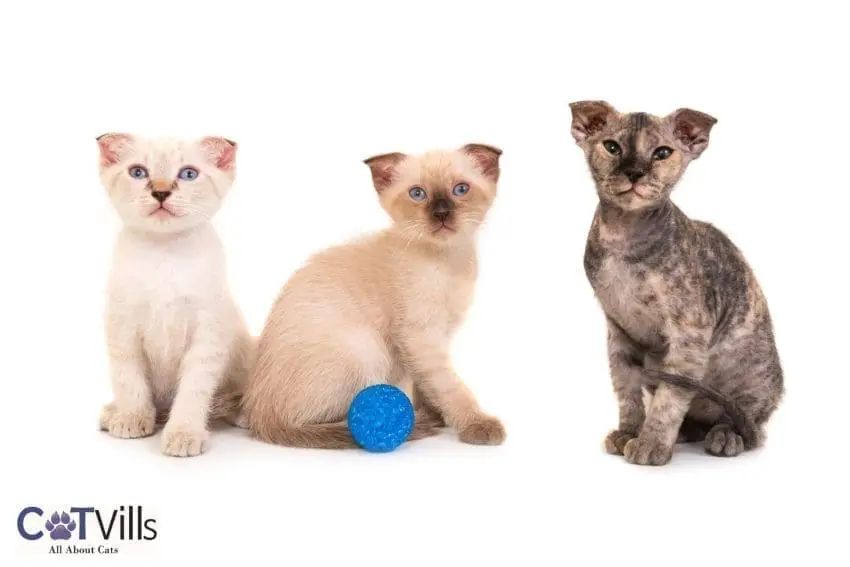
Breeding the Scottish Fold and the hairless Donskoy cat breed resulted in the Ukrainian Levkoy-a gorgeous, hairless, slender, energetic cat with ears that fold forwards.
It’s a recent breed that originated in Ukraine.
From the looks of it, this cat looks laid back. But a few minutes with them reveals that they’re quite active, intelligent, and friendly with people and pets.
They did acquire some health issues, such as arthritis, from their parents, the Scottish Fold.
Like other cats with no fur, this breed is sensitive to too hot or too cold temperatures. The ears should also be cleaned regularly.
#5 Elf Cat
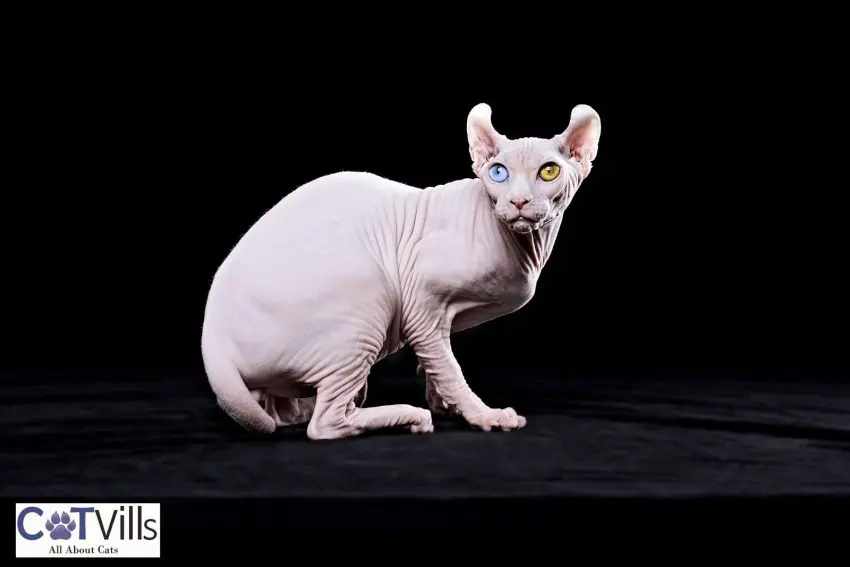
This is another hairless cat with curling ears. But unlike the Ukrainian Levkoy, the ears curl backward.
Why? Because it’s a mixture of the American Curl and the Sphynx.
This breed dates back to 2004, so it has not been around for long, but it’s gaining popularity in cat shows.
The breeders aimed at maintaining both cats’ traits; that’s why the Elf Cat has the same curly ears as the American Curl and a slender body similar to the Sphynx cat.
They are also friendly, playful, and relatively healthy since they didn’t inherit any defects.
But due to their hairless coat, avoid exposing them to too much sunlight to prevent skin damage.
#6 Foldex
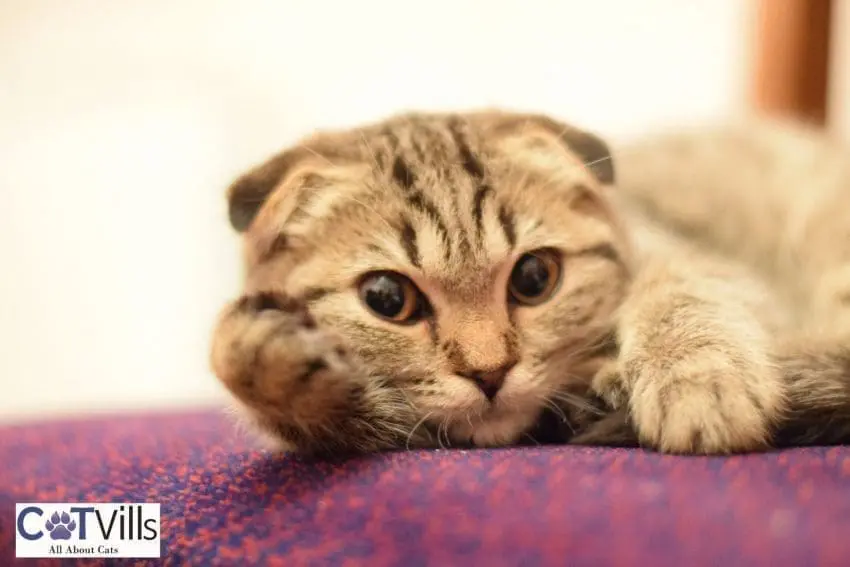
The Foldex is a mixture of the Scottish Fold and the Exotic Shorthair. That’s why they’re sometimes referred to as Exotic Folds.
But unlike in the Scottish Folds, where the ears fold into several rolls, the Foldex’s ears exhibit a single fold or flap.
These exotic cats are quite confident, intelligent, and affectionate.
They’re generally healthy but may be susceptible to Polycystic Kidney Disease and other health conditions that may affect the Scottish Folds.
Why Do Some Cats Have Curled Ears?
Different cat breeds have different genetic makeups.
That’s why some have lush coats, while others have short hair or even no fur. Some may have long, picky ears, while there are cat breeds with big eyes.
And the parent cats pass these genes on to their kittens. However, sometimes various genes mutate in such a way that the kittens exhibit different characteristics from their parents.
That’s what happened to bent-ear cats. The gorgeous curling or folding is a result of a genetic mutation.
However, the mutation also differs among cat breeds. That’s why there are two different types of bent-ear cats – folding to the inside (folding forward) or curling to the outside (curling backward).
Folding Ears
The mutation that causes the ears to fold inward results from an incomplete gene, and it’s associated with cartilage and other bone issues.
So, cats exhibiting this mutation are not that healthy and should be treated with care.
Most of them eventually develop mobility issues. The most popular cat breed with folding ears is the Scottish Fold.
Curling Ears
Unlike in the folding ears, the mutation in these cats causes the ears to curl backward.
It also doesn’t spread to any other part of the body, so these cats are healthier.
However, once the ears curl, they get stiff and sensitive, and you should handle them carefully.
FAQs
Do THOSE CURLY EARS AFFECT THE CAT’S HEARING?
Not really. The mutation only affects the ear’s outward appearance, but the Scottish Folds, American Curls, and other crossbreeds with curled ears don’t appear to have hearing problems.
However, due to the folding, they tend to accumulate dirt first. It’s essential to check and clean them regularly.
Do CATS WITH BENT EARS HAVE HEALTH PROBLEMS?
Yes, the Scottish Folds. The mutation that causes the folding also affects their bone and cartilage development, leading to Degenerative Joint Disease and painful arthritis.
But the mutation in American Curls is different and doesn’t affect other parts of their bodies.
WHERE ARE SCOTTISH FOLD CATS BANNED?
The Scottish Folds are banned by the Cat Fancy of Great Britain (England, Scotland, and Wales) and the Fédération Internationale Féline, which spans more than 40 countries. But they’re still popular in the USA and Japan.
Conclusion
If you’re fascinated by cats with unique features, I believe you’ll love one of these best cat breeds with curled ears.
This mutation now happens in many other cat breeds, so don’t be surprised to find it in the Manx, Cornish Rex, or any other breeds you’re interested in.
What are your favorite cat breeds with curled ears? Share with us!
Resources:
